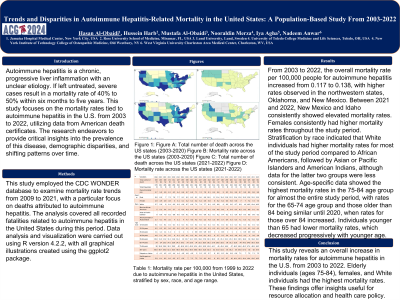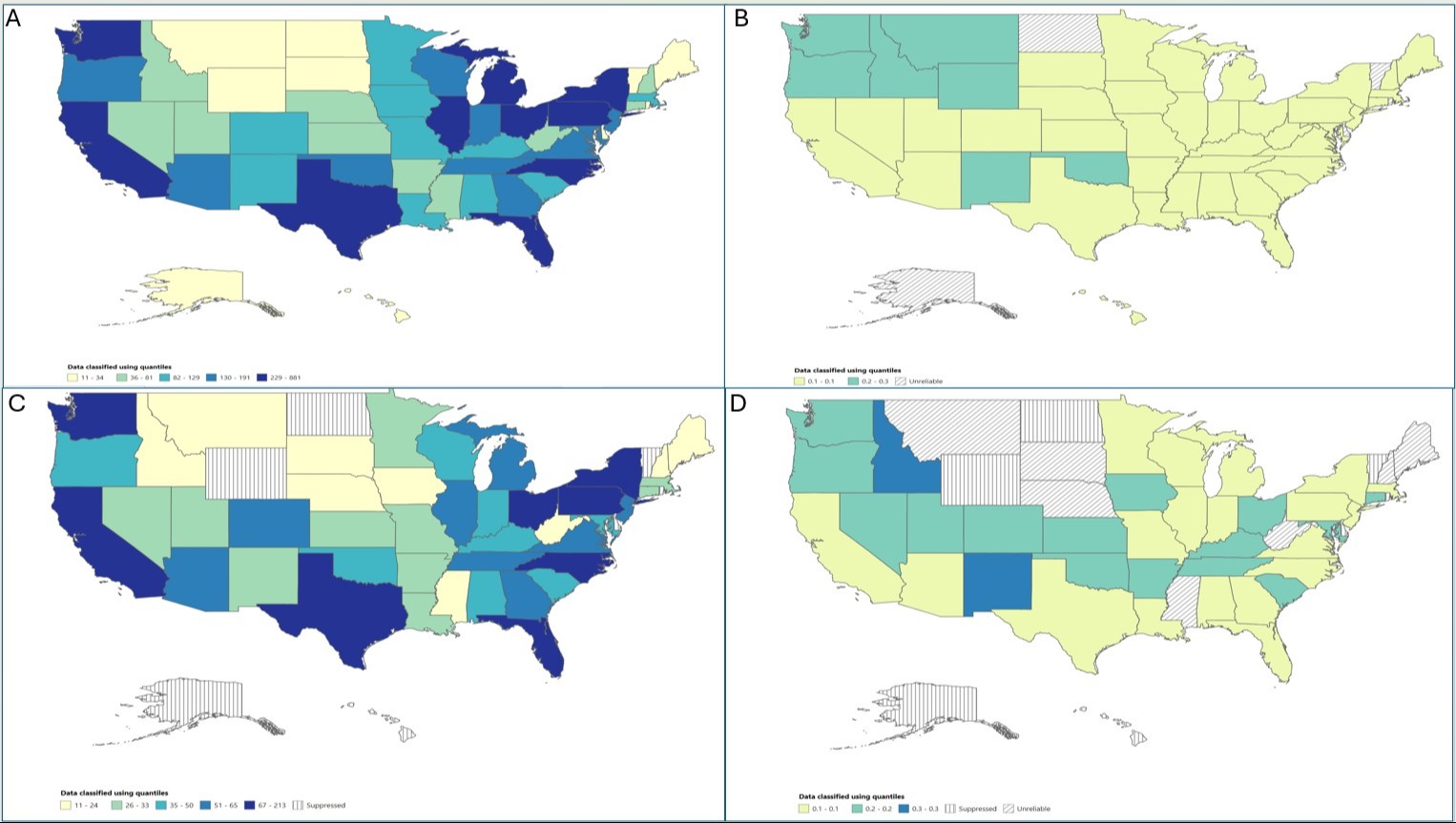Tuesday Poster Session
Category: Liver
P4619 - Trends and Disparities in Autoimmune Hepatitis-Related Mortality in the United States: A Population-Based Study From 2003-2022
Tuesday, October 29, 2024
10:30 AM - 4:00 PM ET
Location: Exhibit Hall E

Has Audio

Hasan Al-Obaidi, MD
Jamaica Hospital Medical Center
Briarwood, NY
Presenting Author(s)
Hasan Al-Obaidi, MD1, Hussein Harb, 2, Mustafa Al-Obaidi, MD3, Nooraldin Merza, MD4, Iya Agha, MS5, Nadeem Anwar, MD6
1Jamaica Hospital Medical Center, Briarwood, NY; 2Ross University School of Medicine, Brooklyn, NY; 3Lund University, Malmö, Skane Lan, Sweden; 4University of Toledo College Medicine and Life Sciences, Toledo, OH; 5New York Institute of Technology College of Osteopathic Medicine, New York, NY; 6West Virginia University Charleston Area Medical Center, Charleston, WV
Introduction: Autoimmune hepatitis is a chronic, progressive liver inflammation with an unclear etiology. If left untreated, severe cases result in a mortality rate of 40% to 50% within six months to five years. This study focuses on the mortality rates tied to autoimmune hepatitis in the U.S. from 2003 to 2022. The abstract endeavors to provide critical insights into the prevalence of this disease, demographic disparities, and shifting patterns over time.
Methods: This study employed the CDC WONDER database to examine mortality rate trends from 2009 to 2021, with a particular focus on deaths attributed to autoimmune hepatitis. The analysis covered all recorded fatalities related to autoimmune hepatitis in the United States during this period. Data analysis and visualization were carried out using R version 4.2.2, with all graphical illustrations created using the ggplot2 package.
Results: From 2003 to 2022, the overall mortality rate per 100,000 people for autoimmune hepatitis increased from 0.117 to 0.138, with higher rates observed in the northwestern states, Oklahoma, and New Mexico. Between 2021 and 2022, New Mexico and Idaho consistently showed elevated mortality rates. Gender analysis revealed that females consistently had higher mortality rates than males throughout the study period. Stratification by race indicated that White individuals had higher mortality rates for most of the study period compared to African Americans, followed by Asian or Pacific Islanders and American Indians. Age-specific data showed the highest mortality rates in the 75-84 age group for almost the entire study period, with rates for the 65-74 age group and those older than 84 being similar until 2020, when rates for those over 84 increased. Individuals younger than 65 had lower mortality rates, which decreased progressively with younger age (Table 1).
Discussion: This study highlights an overall increase in mortality rates per 100,000 individuals for autoimmune hepatitis in the United States from 2003 to 2022. States with initially higher rates, such as those in the northwest, Oklahoma, and New Mexico, saw the most significant rises. Elderly individuals, particularly those aged 75-84, females, and White individuals exhibited the highest mortality rates. This research provides valuable insights into the impact of autoimmune hepatitis on vulnerable populations, guiding resource allocation, policy formulation, and targeted actions to enhance healthcare outcomes.

Note: The table for this abstract can be viewed in the ePoster Gallery section of the ACG 2024 ePoster Site or in The American Journal of Gastroenterology's abstract supplement issue, both of which will be available starting October 27, 2024.
Disclosures:
Hasan Al-Obaidi, MD1, Hussein Harb, 2, Mustafa Al-Obaidi, MD3, Nooraldin Merza, MD4, Iya Agha, MS5, Nadeem Anwar, MD6. P4619 - Trends and Disparities in Autoimmune Hepatitis-Related Mortality in the United States: A Population-Based Study From 2003-2022, ACG 2024 Annual Scientific Meeting Abstracts. Philadelphia, PA: American College of Gastroenterology.
1Jamaica Hospital Medical Center, Briarwood, NY; 2Ross University School of Medicine, Brooklyn, NY; 3Lund University, Malmö, Skane Lan, Sweden; 4University of Toledo College Medicine and Life Sciences, Toledo, OH; 5New York Institute of Technology College of Osteopathic Medicine, New York, NY; 6West Virginia University Charleston Area Medical Center, Charleston, WV
Introduction: Autoimmune hepatitis is a chronic, progressive liver inflammation with an unclear etiology. If left untreated, severe cases result in a mortality rate of 40% to 50% within six months to five years. This study focuses on the mortality rates tied to autoimmune hepatitis in the U.S. from 2003 to 2022. The abstract endeavors to provide critical insights into the prevalence of this disease, demographic disparities, and shifting patterns over time.
Methods: This study employed the CDC WONDER database to examine mortality rate trends from 2009 to 2021, with a particular focus on deaths attributed to autoimmune hepatitis. The analysis covered all recorded fatalities related to autoimmune hepatitis in the United States during this period. Data analysis and visualization were carried out using R version 4.2.2, with all graphical illustrations created using the ggplot2 package.
Results: From 2003 to 2022, the overall mortality rate per 100,000 people for autoimmune hepatitis increased from 0.117 to 0.138, with higher rates observed in the northwestern states, Oklahoma, and New Mexico. Between 2021 and 2022, New Mexico and Idaho consistently showed elevated mortality rates. Gender analysis revealed that females consistently had higher mortality rates than males throughout the study period. Stratification by race indicated that White individuals had higher mortality rates for most of the study period compared to African Americans, followed by Asian or Pacific Islanders and American Indians. Age-specific data showed the highest mortality rates in the 75-84 age group for almost the entire study period, with rates for the 65-74 age group and those older than 84 being similar until 2020, when rates for those over 84 increased. Individuals younger than 65 had lower mortality rates, which decreased progressively with younger age (Table 1).
Discussion: This study highlights an overall increase in mortality rates per 100,000 individuals for autoimmune hepatitis in the United States from 2003 to 2022. States with initially higher rates, such as those in the northwest, Oklahoma, and New Mexico, saw the most significant rises. Elderly individuals, particularly those aged 75-84, females, and White individuals exhibited the highest mortality rates. This research provides valuable insights into the impact of autoimmune hepatitis on vulnerable populations, guiding resource allocation, policy formulation, and targeted actions to enhance healthcare outcomes.

Figure: Figure A: Total number of death across the US states (2003-2020)
Figure B: Mortality rate across the US states (2003-2020)
Figure C: Total number of death across the US states (2021-2022)
Figure D: Mortality rate across the US states (2021-2022)
Figure B: Mortality rate across the US states (2003-2020)
Figure C: Total number of death across the US states (2021-2022)
Figure D: Mortality rate across the US states (2021-2022)
Note: The table for this abstract can be viewed in the ePoster Gallery section of the ACG 2024 ePoster Site or in The American Journal of Gastroenterology's abstract supplement issue, both of which will be available starting October 27, 2024.
Disclosures:
Hasan Al-Obaidi indicated no relevant financial relationships.
Hussein Harb indicated no relevant financial relationships.
Mustafa Al-Obaidi indicated no relevant financial relationships.
Nooraldin Merza indicated no relevant financial relationships.
Iya Agha indicated no relevant financial relationships.
Nadeem Anwar indicated no relevant financial relationships.
Hasan Al-Obaidi, MD1, Hussein Harb, 2, Mustafa Al-Obaidi, MD3, Nooraldin Merza, MD4, Iya Agha, MS5, Nadeem Anwar, MD6. P4619 - Trends and Disparities in Autoimmune Hepatitis-Related Mortality in the United States: A Population-Based Study From 2003-2022, ACG 2024 Annual Scientific Meeting Abstracts. Philadelphia, PA: American College of Gastroenterology.
